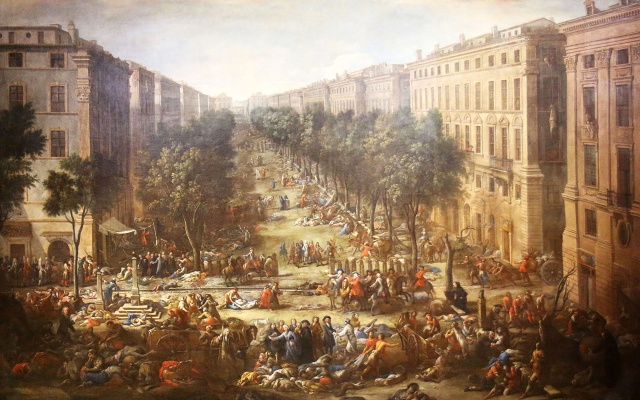The importance of work and the negative image of idleness is, if observed from a macro-historical perspective, a relatively recent phenomenon and it coincides with the rise of bourgeois society in the 19th century. This is quite a broad statement because neither was labor universally praised as a positive value in the 19th century, nor in the former centuries was idleness unconditionally idealized.
If the elite of the ancien régime fancied a calm and idle life (this elite was even legally obliged to refrain from working) it is because physical and even intellectual work was understood as an attribute of the third state. This presumes a certain distribution of functions throughout society that were calibrated to the tripartite system. If the elite was supposed to live idly, it is because originally, its role was to defend society. Idleness didn’t necessarily refer to uselessness. Actually, the opposition between idleness and work is quite misleading in the context of western Christian civilization. This opposition may be pertinent for the analysis of class conflicts, but – to understand the relation between idleness and guilt in the time of the pandemic, in a more general context – it is perhaps more reasonable to focus on the notion of progress (which can be viewed both individually or generally, but which is in our civilization more or less always linear and indefinite) instead of the notion of work.
This specific Christian idea of progress, as linear and continuous work on yourself, started to intensify through a monastic type of power. Here, we want to show that the this type of power is an important structural element of western Christian civilization since it is the basis of our present-day institutions. The quarantine measures implemented recently due to the new coronavirus reflect the permanence of the monastic structure of society. Our reaction to the disease probably shows the persistence of a deep monastic structure that continues to influence our contemporaneity.
In his essay “What is contemporary?” Giorgio Agamben defined the contemporary subject as someone “who firmly holds his gaze on his own time so as to perceive not its light, but rather its darkness”.1 If I change Agamben’s perspective a bit, it would be possible to argue that the coronavirus pandemic, and the resulting confinement, may be the elements that will disclose the “darkness” of our contemporaneity. The goal of this article is to explain, in its larger historical context, the notion of guilt related to contagion and quarantine. It poses a hypothesis that the feeling of guilt in the time of an outbreak demonstrates a persistence of a particular type of discipline.
I could write, by paraphrasing Jacques Le Goff, that there are no renaissances in history, there are, however, times before and after the plague.2 The idea of contemporaneity in western Christian civilization is permeated by the concept of genesis – we think about our past, almost without exception, by imagining a starting point in history and then we proceed by delimiting larger historical periods, where each one is a better version of the former one. When we think for example of individuality, often the starting point is a certain idea of the Renaissance, a sort of “grain” that already contains all the “genetic” material necessary to construct the idea of our contemporary Individual: the renaissance merchant already announces a modern capitalist, the renaissance scientist is already thinking like a modern one, and to create a path from a Renaissance artist to a contemporary one is merely a question of variation in style. When we think about politics, we often choose a different starting point, for example the French revolution. Before the revolution – the enslaved were the king’s subjects; after the revolution they were, and are today, free individuals in a democratic society. It is an ideology strongly anchored by the bourgeois revision of history in the 19th and 20th centuries.3 However, some contemporary historians, like Arno Mayer for example, situate the end of the ancien régime in the period between the two World Wars.4 This thesis seems to be pertinent also for the field of medicine, where the idea of disease and pathology as something that is dehumanized and depersonalized is quite recent and we have to situate it in the period between the two world wars.5
Bronisław Geremek stated that the history of a particular civilization can’t be easily divided according to a strict hierarchy of values, and that there are always the remains of ancient stages of cultural development that persist through history.6 Foucault underlined a similar problem when establishing discontinuities: “We may wish to draw a dividing-line; but any limit we set may perhaps be no more than an arbitrary division in a constantly mobile whole.”7 Because we are inclined to think of this “constantly mobile whole” as coming from a positive starting point, we present these divisions to ourselves as a sort of cultural separation from our past. To be able to somehow unify the historical timeline and understand the persistence of some social structures, it is important to use quite an original method of analysis. One such attempt is Bartlomé Clavero’s approach to historical research, where he tries to oppose the tendency to think about history in terms of origin. He showed that until the end of the 18th century the economy was strongly dependent on canonical law and catholic values.8 With Clavero we can thus think of the economy not in the positive sense of the origin of capitalism but in the sense of the decomposition or devolution of a religious order of exchange. A similar shift in perspective is possible in the case of other practices and domains as well. Instead of constructing a positive vision of the evolution of modern science from the time of the Renaissance, it would also be pertinent to follow the resistance or weakening of the antiquated vision of the world.
Scientists, especially in medicine, were under the strong influence of antiquity until the early 20th century. It is not difficult to find surgeons at the beginning of the 20th century, who still believed that hypochondria could be treated with a surgical operation of some peripheral organs, like the kidney or uterus.9 No matter how strange it may seem, these doctors are maybe closer to antiquity than to their contemporary colleagues. Artists were often considered to be simple manual workers until the late 19th century, and the resistance or incapacity of 19th-century authorities to establish intellectual property law is largely a consequence of this ambiguous position of the artist situated between his desire to become a noble and the need to openly advocate for this economic aspect of intellectual work.10 That is why, we have to reconsider our idea of the ancient and contemporary. The current situation of the pandemic, our response to this specific sanitary problem, and intensification of culpability that has emerged, will enable us to better perceive a certain continuity of the power structure.
The resistance of epistemological periods urges us to examine how the discipline, and, consequently, the obedience in our society link us to our past. The question is: as concerns discipline, who are our contemporaries? The confinement due to the coronavirus pandemic displayed a mixture of two quite symmetric emotions: culpability and relief. It seems as if we would be satisfied and even relieved by the idea that the epidemic is nothing but the reaction of some higher force, like God or Mother Nature, in response to our irresponsible behavior. Contagion is often perceived as nature’s revenge: we were bad and greedy, we were destroying nature, and now nature strikes back. After merely a month of quarantine, the satellite images were already showing cleaner air, animals had taken over the spaces that had previously been taken from them and we could see dolphins in the ports or deer in the streets; the ozone hole had miraculously closed up again. In two months of relative human inactivity, nature has seemingly repaired our sins.
We use scientific measurements to express the culpability of human civilization as a whole. We found a way to measure our guilt by the level of the particles in the air. Maybe we can say that we feel relieved because we can observe our culpability in all its splendor. The current quarantine is thus a marvelous spectacle of “auto-flagellation” on a global level. We are satisfied with the idea of a supreme order being finally coherent and visible. Life seems easier because we have the privilege to feel small and humble again. This supreme order enables us also to rediscover “fundamental” values and relearn basic activities. We bake our own bread; we only buy things we have to. We have rediscovered our children, with whom we spend much more time, but we have also re-evaluated our emotions towards our parents, because it is advised not to visit them.
In this sense, our perception of the epidemic is still quite Manichean. It somehow can’t be considered beyond the idea of good and evil, because we are still operating within the Christian logical and disciplinary system. This confinement shows the richness of our religiosity. It is quite possible that we never entered a real secularization process, and that our religion, by changing its objectives, by becoming more “terrestrial,” more “materialistic,” has only grown stronger in the past few centuries. In his lectures at College de France on Security, Territory and Population, Foucault argued that the development of the state in the 17th and 18th century could be understood as the intensification of a pastoral type of power.11 Our reaction to the pandemic and the intensified feeling of guilt might prove that we are still living under a particular type of religiosity and its disciplinary system.
The discourse of contagion and guilt
The pandemic is thus capable of showing us the fragility of our idea of being contemporary. Our reaction to contagion is quite similar to the reaction of people from the 17th or 18th century. In terms of discipline, we still living in the same epistemological period. What brings us closer to our past, is precisely the feeling of guilt during this time of contagion. It is this emotion that generates our various reactions towards contagion. The 17th/18th-century discourse on the plague, its general structure, the way the disease was perceived, the reaction to it, and the collective feeling of guilt, are quite similar to our own situation with the coronavirus. For the people of the ancien régime, the plague formed a specific situation of widespread and implacable disaster that could be explained more or less only through the notion of collective guilt. The disease itself, in spite of the fact that it can emerge for sensible reasons, is almost always understood as a punishment. Françoise Hildesheimer reasonably noticed, that in order to understand the plague, the people of the ancien régime had to compare it with all other cases of plague and then all these cases formed a kind of mythical corpus.12 As an isolated event, the plague would not have made any sense.
The plague epidemic was a situation where the individual was less important than society, and the medical measures taken were less important than those taken by the police.13 Foucault refers to this when he writes that “A medicine of epidemics could exist only if supplemented by police.”14 To simplify the comparison of our quarantine world with the ancient ones, I will take as an example the book Relation historique de la peste de Marseille en 1720 [A historical account of the plague of Marseille in 1720], written by a doctor Jean Baptiste Bertrand, a contemporary of the infamous plague of Marseille.
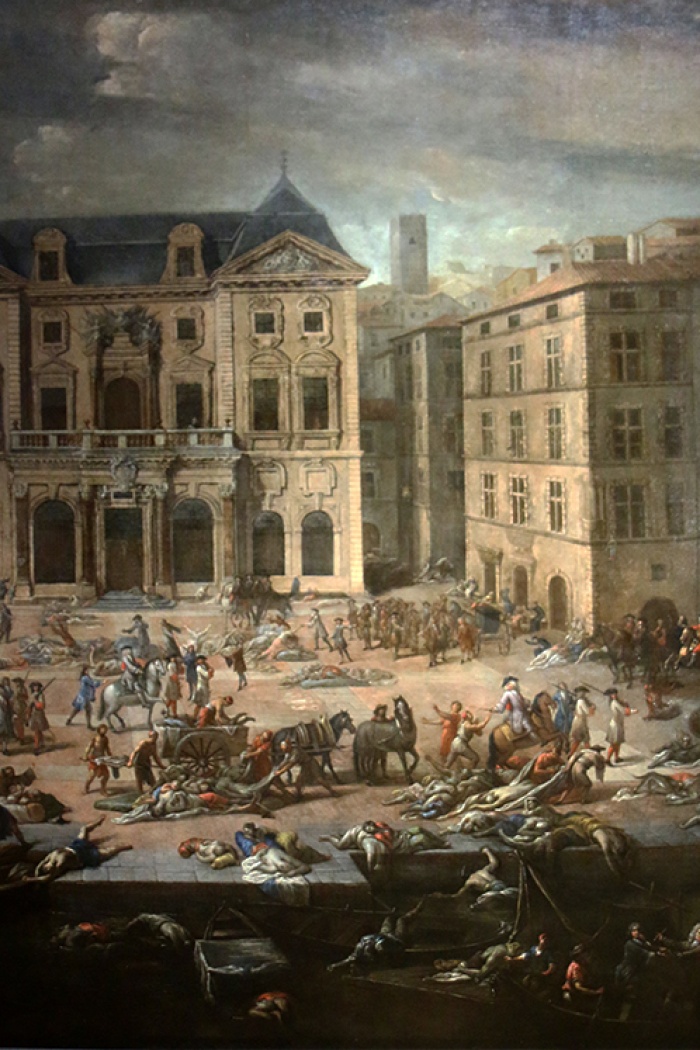
Michel Serre, Vue de l'hôtel de ville de Marseille pendant le peste de 1720. Źródło: wikimedia commons.
The author starts with a dramatic description of the plague, being the worst of all calamities, in comparison with the war and the famine: “The misfortunes of contagion are much more overwhelming, longer and more awful. It is an implacable enemy, whose features are all the more dangerous as they are invisible and more widespread, against which the most exact precautions are often vain and useless.” The implacable character of the enemy is what makes it so threatening and dangerous. The power, whether it is a state, religious, or municipal authority, has to operate in the dark, has to palpate this invisible enemy without really knowing if any measures will bring about a result. The spectacle of the plague was terrifying because it tore the social fabric in a short amount of time: “…in a few days, it makes a dreadful desert of the most populous and opulent city in the world, and fills it with horror and misery.” The period of the plague epidemic is a period of fear and suspicion: “We see the inhabitants of the same city avoid each other and flee; everyone is afraid of receiving some deadly impression from those to whom he gives the same fear: everyone locks in and tightens, everything becomes suspect and dangerous.”
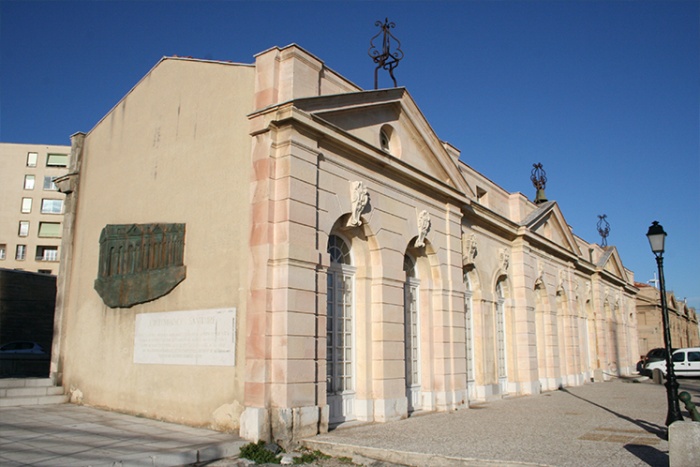
Biuro zdrowia w Marsylii zbudowane w 1719 r. Zdjęcie: Robert Valette. Źródło: wikimedia commons.
After presenting such a rich and intense description of the calamity of the plague, the author concludes that “So many misfortunes which follow the contagion, should make it look more like a scourge of Heaven than the effect of a natural revolution.” 15 This shows that there is a threshold, beyond which the punishment, and thus the collective guilt, is the only possible explanation. When a crisis is incomprehensible, when it can’t be explained, then the punishment is left as the only possible conclusion. Here a reader could object that this way of thinking is an anthropological or common quality, that a search for a divine origin of the catastrophe is a natural, human thing. But it would be difficult to prove that the same collective emotion existed in Ancient Greece or Rome. In Antiquity, the notion of disease and its relation to the subject as well as the idea of culpability, if it ever existed, was different. Florence Dupont argues that in Rome, and even in Ancient Greece, the plague was more a signal that something was wrong, or that politicians were guilty, but the feeling of guilt was not attributed to the society as a whole.16
As historians often stress, the discourse on the plague is very repetitive and monotonous, it seems that for centuries, it has remained the same, and that the way the plague is understood has remain the same. Noël Coste, however, carried out statistical research on plague literature available in French in the period of ancien régime, and he proved that the percentage of books explaining the origin of the plague as being based in God’s ire significantly increased in the second half of the 16th century, after catholic discipline hardened.17
But it is not only about the statistics of the origins, but also about the structure of discourse in these works. The notion of guilt no only reflects the general statements about the origins of the plague, but the way in which the book conceptually refers to guilt. Bertrand is precise that there were twenty outbreaks in total and they were, according to the author, all the same, it is always the same phenomenon, the same disease. By analyzing each and every plague, the author creates an introspection of the social body and mind. It is a common feature of all plague literature authors, that they are looking to find its origins in the sins of an ancient civilization.18 It is almost like they want to construct a register of social sins in preparation for a collective act of confession. The search for collective guilt unifies society. The political body becomes responsible as a whole, and this makes possible the introduction of extreme discipline measures. It is this feeling of guilt that puts police before medicine.
Particular authors can then focus on the secondary reasons that can be external or internal. According to Bertrand, due to a lack of significant economic, demographic, or commercial factors that could have provoked such a large outbreak in the region of Marseille, and because the society at that time had, according to the author, a positive outlook, he concluded that the misfortune of plague had to come from outside. But some other authors could have come to the opposite conclusion, they could have detected certain irregularities or corruption in the community and then advocated for ways to understand the plague from within their own communities.19 In any case, whether the secondary reasons are external or internal, the plague operates as a strong unifying tool, enabling society to undergo an intense feeling of guilt.
The chronology of the plague’s spread in Marseille is shorter version of the epidemic of coronavirus. The suspected boat came from the east. On arrival, it was put in quarantine, but the city doctors, in spite of the visible symptoms, hesitated a long time before confirming the outbreak of plague. Then the disease managed to exit the lazaret and started to spread through the city. The first sick people were confirmed; people started to gossip, who got what from who, who is the first person that got sick, which street was first, what kind of people lived in the contaminated areas. It seems like the disease was related to a particular street or quarter, then it crossed over from one to the other.20 As if the moral status of a particular urban area, a particular street or quarter, were a pertinent element to understand how the plague was spread.
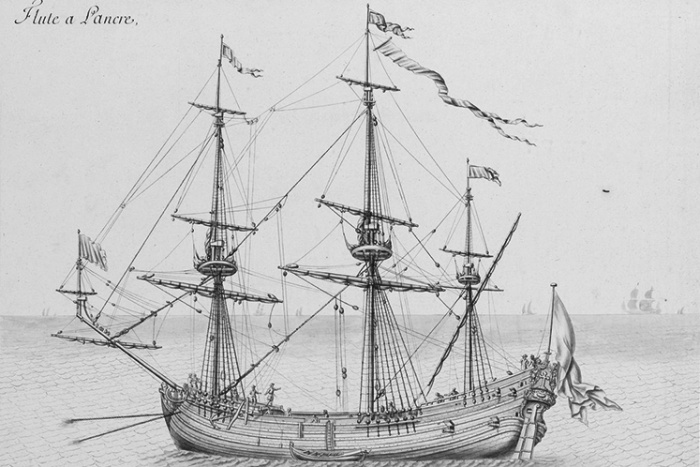
Nicolas de Poilly. Rycina przedstawiająca fluitę, typowy statek handlowy z tego okresu. Źródło: wikimedia commons,
The chronology of a disease is related to its causality and culpability. First, there is a general culpability because the outbreak must have been a scourge from heaven, it can’t be just a natural phenomenon. Then the culpability that follows is either of an ethnic or geographic nature, the disease comes usually from the east, the orient, from the barbaric part of the world where people are not civilized enough to take necessary measures concerning quarantine and policing. Bertrand says that the suspected boat travelled from Sidon to Tripoli and he underlines the well-known fact that in the Levant people continue to trade despite the outbreak. The entry “Peste” in the Encyclopedia says that “…for two thousand years all the plagues that appeared in Europe were transmitted through the communication of the Saracens, Arabs, Moors, or Turks with us…” The plague “is preserved there by their bizarre way of thinking about predestination: persuaded that they cannot escape the order of the God over their fate, they take no precaution to prevent the progress of the plague…” Then there is the culpability of the street, the quarter, a particular family, a particular profession etc. In the current pandemic, there is also a complex structure of causality and guilt. There is the general guilt of global society regarding nature, but there is also the guilt of Chinese people on a world-scale, or Italians on a European-scale. There are certain groups of people that are more responsible than the others, for example, the tourists that went to ski in Italy and Austria are perceived as the ones who were the most responsible for the spread of coronavirus. For others, like right-wing politicians, the guilty ones are immigrants. It would be possible to continue until smallest elements of society were found guilty.
Such a linear understanding of the outbreak reflects our deep cultural structure. We have to think about the outbreak in this manner because of the relationship between discipline and guilt. The strategy of accusing the other is what results in the formation of the monastery-like institution. And it is inside such an institution, that we can be disciplined and obedient, and consequently feel insupportable guilt when doing nothing wrong. It is exactly this unity of discipline and guilt that makes us unique in the history of civilizations. That is why we have to describe this discipline to understand the contagion and our behavior and emotions in the time of quarantine. Looked at from the perspective of our reaction to contagious outbreaks, we are still living inside this same long historical period. It is a period where a very particular discipline rules, where every individual knows exactly where his place is, what his function is, and how he should proceed.
Evolution of discipline
Foucault often uses a society’s reaction to disease to describe particular forms of discipline and the way in which power treats its subjects. He juxtaposed two diseases, two models. The first one is leprosy, where power excludes the subjects without analyzing them, leaving them more or less to their own destiny. The second is a plague model where the power isolates and divides the political space into smaller units so that this space can be analyzed and surveilled. Foucault’s description of the plague in Discipline and Punishment is quite famous: “First, a strict spatial partitioning: the closing of the town and its outlying districts, a prohibition to leave the town on pain of death, the killing of all stray animals; the division of the town into distinct quarters, each governed by an intendant. Each street is placed under the authority of a syndic, who keeps it under surveillance; if he leaves the street, he will be condemned to death. On the appointed day, everyone is ordered to stay indoors: it is forbidden to leave on pain of death.”21 According to Foucault, this disciplinary dispositive was meant not only to deal with the sanitary crisis but was also a universal disciplinary regime that governed the market of wheat and practically every economic domain of society.22 This discipline system is analytical, but it tries to separate society from a particular external danger: disease, famine, luxury, etc. The laws of the ancien régime indeed show the obsession of power to imagine every possible contact between the subjects and “contagious” elements or phenomena and thereby to consequently invent laws which will prevent these types of contact. In the case of an epidemic, there is a quarantined town, in the case of famine, there is an isolated province prohibited from exporting wheat. But there is also college, an educational institution where the students are isolated from the rest of the population so that they can be protected from bad influences.
Foucault showed how in the 18th century, this old disciplinary system started to evolve. The power, not only centralized power, but also the power at the lower levels, started to consider the crisis as a substantial element of nature or society, and thus started to somehow play with it, including it in its political measures. The mortality and the disease ceased to be viewed as fatal events that can never be controlled and could spread due to the slightest loosening of safety measures. Instead they become statistics – a percentage, a number – and thus modifiable.23
This new dispositive tries not only to protect the individuals, like in the case of plague, but it tries to improve them within different disciplinary spaces. To illustrate this new dispositive Foucault carries out an analysis of Bentham’s panopticon as the architectural form of this new type of power. Its architectural form, a watchtower in the center and the large circle of prison cells around it enable the constant surveillance of prisoners. The prisoners, not able to see the guard at any time, have a feeling of being under constant surveillance. The difference between the isolated and quarantined city and the space of Bentham’s prison is that the first one only tries to protect by separation, while the second one unifies the disciplinary space and tries constantly to improve the individuals. The new dispositive of security, as opposed to the dispositive of discipline, seems to have more confidence in his subjects, but this confidence is the result of surveillance and certain knowledge that comes from it. So according to Foucault, there is a certain evolution of discipline and the turning point is the period of the 18th century.
Here we have to go back to the problem of historical cuts, mentioned at the beginning of the article. What Foucault makes here is a certain epistemological division of discipline. It seems as if the new disciplinary system would be “born.” Yet, we have found ourselves today, literally overnight, in the old system that isolates and immobilizes, that doesn’t care so much if we are becoming better and more efficient or not, its principal objective is that we stay at home. We found ourselves in the time and space of a power that doesn’t have confidence in its subjects. The power even forces us to be inactive, in order to protect ourselves. The idea of guilt serves as a tool to confinement. It seems that our “neoliberal” system of discipline, based on free movement and unconditional growth, never existed.
To perceive this problem from a much bigger, macro-historical perspective, it is necessary to be precise that our society, all its institutions, all its disciplinary techniques, all its richness of power relations comes from the institution of the coenobitic monastery. If take that as a starting point, then it is this old institution that we have to focus on. In her article on the first coenobitic monasteries, Nira Gradowicz-Pancer says that the coenobitic monastery implemented the panoptical form of power by using a tridimensional type of surveillance: a horizontal type that operated between monks themselves, a vertical type that functions between the different hierarchies within the monastery and the third dimension which is more ideological than architectural, and it is founded on the idea that God is constantly surveilling. In the coenobitic monastery, this idea of god's omnipresence is intensified exactly through this tridimensional type of surveillance. The monastery is in this sense a perfect disciplinary machine.
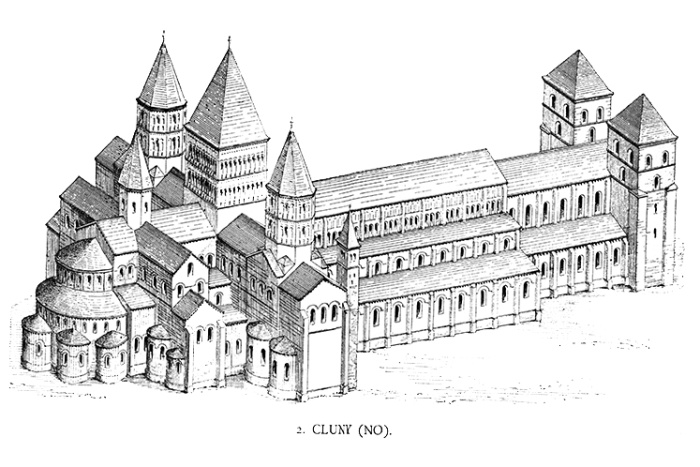
Opactwo w Cluny (katedra, rekonstrukcja). Rycina nr 212 [w:] Georg Dehio/Gustav von Bezold: Kirchliche Baukunst des Abendlandes. Stuttgart: Verlag der Cotta'schen Buchhandlung 1887-1901. Źródło: wikimedia commons.
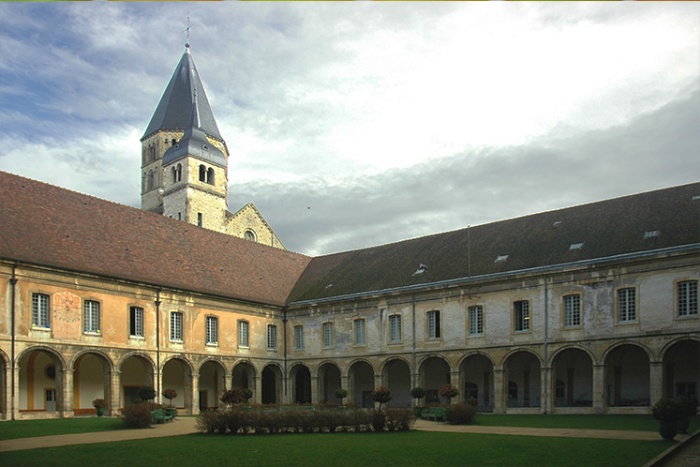
Opactwo w Cluny. Źródło: wikimedia commons.
Analyzed from a macro-historic point of view, it is possible to argue that western civilization is nothing but a long and slow implementation of monastery rules on to the society at large. Christian civilization offers a magnificent gallery of disciplinary institutions that derive from the coenobitic monastery. The feeling of guilt is a fundamental part of these institutions. There is, for example, the problematic beggar of the 17th century, often a teenager or a child, and the general hospital. The beggar is guilty because he resembles a savage animal that is dangerous for civilized society. According to Antoine Godeau, one of the first members of the French Academy, there is something very unaesthetic and dangerous about a beggar as he is perceived as a threat to the state and compared to a beast.24 The primary function of a general hospital is to teach beggars to worship God. The lessons of catechisms were the main aspect of everyday life in this institution. In the 19th century, the madman appears as a subject who presents a principal threat to society: women that commit adultery and destroy the family, a teenager that masturbates, an adult that can’t resist drinking alcohol etc. Madness is a threat, and that is why it has to be isolated. But the madman is also imprisoned because the society and challenges of everyday life are a threat to him. The schools are functioning on exactly the same principles. The Royal Academy of Painting and Sculpture was also organized as a strict hierarchical structure where the chain of obedience tries to determine not only the behavior of the students but also the way they think. All these “imprisonments” are permeated with the concept of a monastery. Perceived from outside, they are isolated in order to secure themselves from contagion from the outside world; from inside, they are a disciplinary machine for improvement, where mutual concurrences stimulate individual progress.
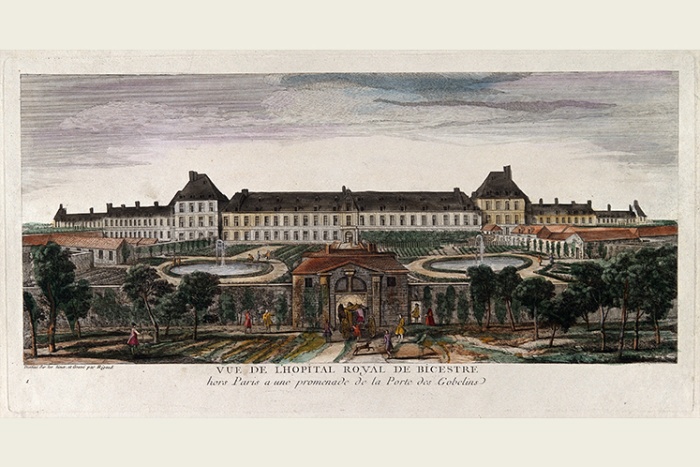
Jacques Rigaud, Hôpital Royal de Bicêtre, Paryż: panorama z ujęciem ogrodów. Akwaforta J. Rigaud. Credit: Wellcome Collection. Attribution 4.0 International (CC BY 4.0)
Our society thus can be analyzed as a network of monastery-like institutions, which grows stronger or weaker according to its particular historical conditions. From this point of view, the current situation doesn’t pose a particular challenge. It will not bring any major changes in our everyday habits probably. Our history is riddled with quarantine experiences. We were, in a certain sense, living it intensively even before the pandemics. The European Union is a form of political quarantine. Educational institutions are a form of positive quarantine, because they reward the good subjects and weed out the bad ones. From an institutional or political perspective, the world is still the same, nothing has really changed. We are still subjects who are eager to improve, disciplined and obedient: even when we are forced to stay at home. If we don’t improve, then we are seized with a feeling of guilt.
BIO
Andrej Pezelj was born in Rijeka, Croatia. In 1998, he enrolled at the Ljubljana Academy of Fine Arts, and graduated in 2003. While a student there he attended the National College of Art and Design in Dublin as part of the Erasmus program. In 2004, he moved to Paris, where he graduated from the Faculty of Paris VIII. In 2016, he received his PhD from the Faculty of Arts, Department of Sociology of Culture, under the mentorship of Rastko Močnik. He teaches art theory and critique at the Academy of Arts at the University of Nova Gorica. In 2016, he published a book Art and Discipline: A History of How Artists, Weavers, and Beggars were Trained in the Classical Age, (edition house *cf. in Ljubljana, Slovenia).
*Cover photo: Michel Serre, Vue du Cours pendant la peste de 1720, source: wikimedia commons.
[1] Giorgio Agamben, What is an apparatus and other essays, p. 29. Available at: https://eastbayprisonersupport.files.wordpress.com/2009/09/what-is-an-apparatus.pdf. Here we use this statement without referring to his denialist attitude to the current pandemic.
[2] Jacques Le Goff, “Pour un autre moyen âge” in: Un Autre moyen âge”, Gallimard, Quarto, Paris, 1999, p. 448–449.
[3] Cf. for example Michel Foucault, Society Must Be Defended : Lectures at the College de France, 1975–76, Penguin books, London, 2005.
[4] Arno Mayer, The Persistence of the Old Regime: Europe to the Great War, Pantheon Books, New York 1981.
[5] Georges Canguilhem, Le normal et le pathologique, PUF, Paris, 1966. For example chapter IV, where Canguilhem analyzes the work of René Leriche and his idea of pathology.
[6] Bronisław Geremek, Usmiljenje in vislice: Zgodovina revščine in milosrčnosti, Studia humanitatis, Ljubljana, 1996, p. 29.
[7] Michel Foucault, The Order of Things: An Archeology of the Human Sciences, Vintage Books, New York, 1994, p. 50. Available at : https://monoskop.org/images/a/a2/Foucault_Michel_The_Order_of_Things_1994.pdf
[8] Bartolome Clavero, La grâce du don, Anthropologie catholique de l’économie moderne, Albin Michel, Paris, 1996.
[9] Lucien Picqué, Psychopathies et chirurgie: doctrines et faits, Masson, Paris, 1912.
[10] cf. Alain Vaillant. “L'aliénation de l'écrivain”, In: Romantisme, 1990, n°67, pp. 3-16.
[11] Michel Foucault, Security, territory, population: lectures at the Collège de France, 1977–78, Palgrave/Macmillan, London, 2007.
[12] Françoise Hildesheimer, La Terreur et la pitié: l’Ancien régime à l'épreuve de la peste, Publisud, Paris 1990, p. 40.
[13] Françoise Hildesheimer, ibid., p. 40-41.
[14] Michel Foucault, The Birth of the Clinic: An Archaeology of Medical Perception, Routledge (ebook), 2003, p. 25. Available at: https://monoskop.org/images/9/92/Foucault_Michel_The_Birth_of_the_Clinic_1976.pdf
[15] Jean-Baptiste Bertrand, Relation historique de la peste de Marseille en 1720, J. Mossy, Amsterdam,1779, p. 1–7, available at: https://gallica.bnf.fr/ark:/12148/bpt6k5750732f/f7.image.texteImage
[16] Florence Dupont, “Pestes d'hier, pestes d'aujourd'hui”, in: Histoire, économie et société, 1984, 3rd year, n°4. Santé, médecine et politiques de santé. pp. 514-515; available at : https://www.persee.fr/docAsPDF/hes_0752-5702_1984_num_3_4_1370.pdf
[17] Joël Coste, Représentations et comportements en temps d’épidemie dans la literature imprimée de peste (1490–1725), Champion Honoré, Paris, 2007, p. 97.
[18] Cf. Andrej Pezelj, Umetnost in disciplina : Zgodovina urjenja umetnikov, tkalcev in beračev v klasični dobi, Cf. edition, Ljubljana, 2016, p. 35, note 9.
[19] Carrière, Charles; Courdurié, Marcel; Rebuffat, Ferréol, Marseille ville morte: La peste de 1720, Autres Temps, Gémenos, 2008, p. 148-150.
[20] Jean-Baptiste Bertrand, Relation historique de la peste de Marseille en 1720…, p. 35-36.
[21] Michel Foucault, Discipline and Punish: The Birth of the Prison, Random House, New York, 1991, p. 195. Available at: https://monoskop.org/images/4/43/Foucault_Michel_Discipline_and_Punish_The_Birth_of_the_Prison_1977_1995.pdf
[22] Michel Foucault, Security, territory, population …, lesson of 18. January 1978.
[23] Michel Foucault, Security, territory, population …, lesson of 25. January 1978.
[24] Antoine Godeau, Discours sur l’establissement de l’Hospital général, fondé à Paris par le Roy, en l’année 1657, A. Vitré, Paris, 1657, pp. 18–19.



